Let’s settle one of the great kitchen debates.
You pull out the toast. Reach for the butter.
And there it is—your soft, golden stick, sitting proudly in a cute little dish like it’s been there all week.
But then… doubt creeps in.
“Wait—is this safe?”
“Isn’t dairy supposed to be refrigerated?”
“Could I be spreading bacteria… or worse, rancid butter?”
Cue the food safety panic.Groceries
Here’s the good news:
Yes, it’s generally safe to leave butter on the counter—if you do it wisely.
Butter isn’t like milk or chicken.
Its unique makeup makes it one of the few dairy products that can chill out (literally and figuratively) outside the fridge—for days, even weeks—with little risk.
Let’s clear up the confusion with facts, not fear.
Why Butter Can Survive (and Thrive) at Room Temperature
The secret lies in its science-backed simplicity:
High fat, low moisture: Butter is about 80% fat and only 15–18% water. Bacteria need moisture to grow—so butter’s dry environment naturally resists spoilage.
Salt is a preservative: Salted butter (most store-bought sticks) has added salt, which further inhibits microbial growth.
Acidity helps too: Cultured butter or European-style butters have a slightly acidic pH, making them less hospitable to bad bugs.
In short:
Butter doesn’t “go bad” the way other dairy does.
Instead, over time, it may become rancid—a flavor issue, not usually a safety one.
How Long Can Butter Sit Out Safely?
It depends on your kitchen—and how you store it.
Below 70°F (21°C), covered
see next page
ADVERTISEMENT

